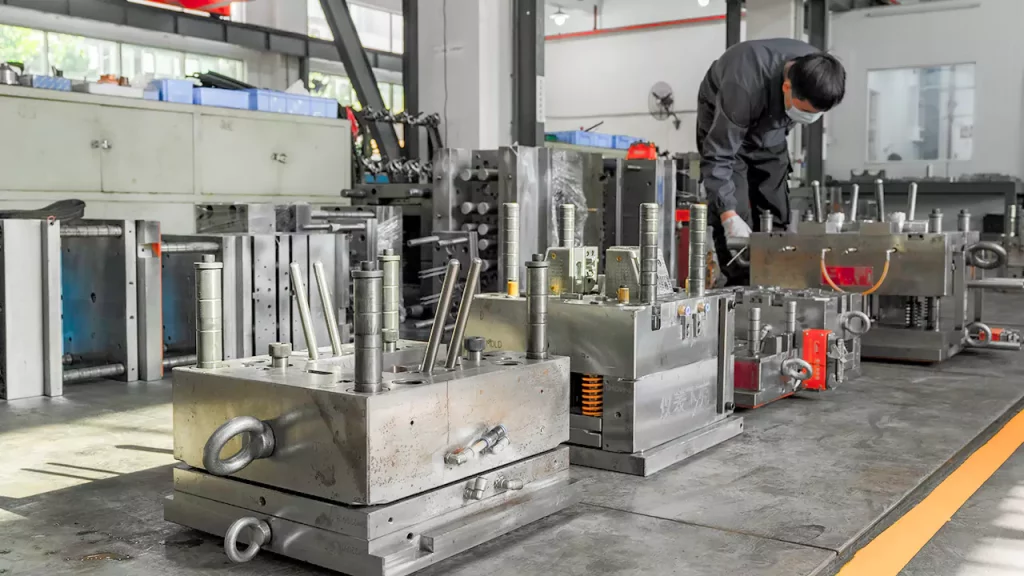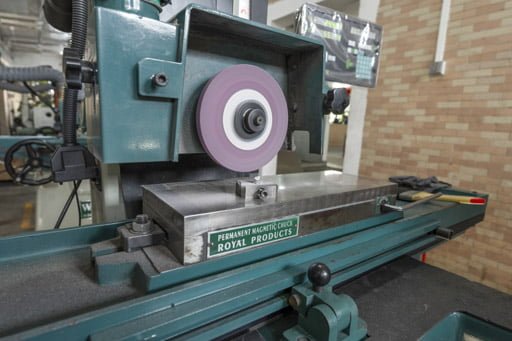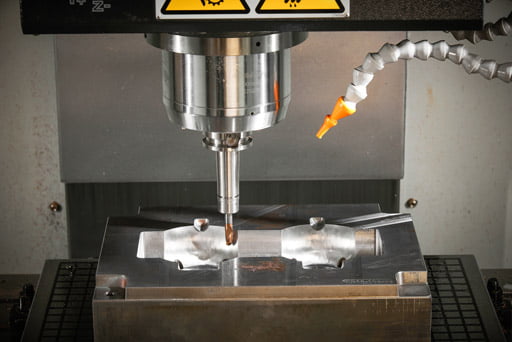どうすればより良い製造ができるのか、興味はないだろうか。 高品質のプラスチック射出成形金型?プラスチック射出成形部品の世界市場規模は現在$3,250億円で、少なくとも2025年までは5.7%の増加が見込まれている。
このような採用の拡大を考えると、プラスチック射出成形の最も顕著な利点のひとつが、研究コスト(金型製作)に比べて低い単価で大量生産できることであることは明らかだ。一方、このような大量生産には、強力な設計手法が必要である。少量生産では取るに足らないように見える単純で漸進的な金型設計の変更でも、何百万個もの完成部品を評価すると、予算に大きな影響を与えることがある。その結果、どのような金型プロジェクトであっても、その初期段階からしっかりとした設計思考を用いることは理にかなっている。
しかし、プラスチック射出成形用金型の設計と製造において、高品質な結果を得るためには、それがすべてではありません。実際、さまざまな要因が金型の品質向上に役立ち、生産者はより高品質のプラスチック射出成形用金型を作ることができる。
この記事では、そのような要素と、高品質のプラスチック射出成形金型製造工程でそれらがどのように実装されるかを詳しく見ていく。

何よりもまず:高品質のプラスチック射出成形金型加工には精密検査が欠かせない
射出成形部品の加工と製造を始める前に、初心者であろうと製造分野のベテランであろうと、最初の試作品をいくつか作って検査することは常に良い考えです。検査結果を、金型を保管する前に取得した精度検査結果や、使用中の最後の部品の検査で受けた結果と比較します。この検査によって、金型が正しく取り付けられ、調整されたかどうかを判断することができます。さらに、金型が使用される前に、最初の部品を検証し、妥当性を確認する必要があります。 大量生産 大量の高品質プラスチック射出成形金型の。
さらに、金型加工や製造の過程で、あらかじめ決められた射出間隔を置いた後、あるいはあらかじめ決められた数の部品ができた後に、数種類の部品について抜き取り検査を行うことも必要です。これは中間検査として知られている。中間検査の目的は、金型が稼動している間に、金型のさまざまな部品の摩耗速度を把握し、金型の摩耗速度が金型の精度や部品の品質に与える影響を分析して、さまざまな不適格な製品がバッチで作られるのを避けることです。これは、1つのバッチで多数の不適格な製品が作られるのを避けるために行われる。
金型の製造が完了したら、製品の品質を再確認することが重要です。さらに、金型の外観の評価とともに、金型の各部品がどの程度摩耗しているか、金型の修理や再加工が必要かどうかを確認することも重要である。

さらに、初期検査と最終検査の結果を比較することで、金型の摩耗速度を判断することもできます。このような検査を行うことで、後続の部品製造バッチを合理的に編成することができ、その後の金型使用時に再研磨や補修が必要となり、作業が中断されることによる損失を回避することができます。
射出成形金型の修理は、部品の交換や金型の分解・組立・調整により、各部品の精度に大きな影響を与える可能性が高い。その結果、修正後に再度精度検査を行うことになります。主な検査工程と前提条件は、新しい金型を保管する際に必要なものと同じです。
高品質のプラスチック射出成形金型を作るための考慮事項:
- 構造の設計:
成型金型の構造は、次のような製品の材料特性を考慮に入れているだけではない。 縮みまた、冷却水の速度や開閉モードの速度も考慮する。
金型に賢明な構造を採用することで、金型の寿命を効果的に延ばすことができ、高品質のプラスチック射出成形金型の製造がスムーズに行われるようになります。コストを削減しながら、生産性を高める。
- 標準部品の最終決定:
クラシックピースは、金型を成形するプロセスには直接関与しないが、金型全体の動作には影響を与える。
良い標準品とは、摩耗に強く、十分な硬度を持ち、精度が高く、容易に変形しないものでなければならない。
さまざまなブランドが豊富な種類の標準部品を提供しているからといって、安易に価格競争をしてはならない。
- 処理:
成形工程を事前に計画することが最も重要です。合理的な工程設定により、生産サイクルをスピードアップし、処理時間を短縮し、大幅なコスト削減オプションを評価することができます。
その間に 高品質のプラスチック射出成形金型 製造工程では、金型の安定性を維持し、耐用年数を延ばすために、金型が正確かつ合理的に加工されていることを保証することが最も必要である。加工ミスは金型の焼付きや溶着の原因となり、溶着の良し悪しにかかわらず金型にとって損失となる。さらに、金型の動きにも影響を与え、金型の寿命を縮め、生産工程で使用している最中にも金型が破損する可能性がある。
- 研磨:
高品質のプラスチック射出成形金型の製造は、製造された金型そのものを研磨する工程で終了します。にもかかわらず、研磨はプラスチック片に直接反映されるため、最も重要なステップです。
研磨はまた、金型の作用、特に脱型工程に有益である。
しかし、この工程を省略すると、金型製作がスムーズに進まなくなります。この欠陥は通常、ポリッシュがあるべき位置になかったり、抵抗が高すぎたりした結果生じるもので、どちらも脱型、ストレスマーク、トップエンド・クラック、その他の問題につながる。
- 組み立てる:
つまり、金型の組み立ては、機械やあらゆる部品の組み立てに似ている。各ネジがうまくいかないと、その反動は深刻で、最悪の場合、製品の欠陥につながったり、生産に支障をきたしたり、金型が完全に壊れてスクラップが発生したりする。
そのため、組み立て工程は細心の注意を払わなければならない。そのため、組み立て工程では金型の洗浄に特に注意を払う必要がある。特に、水路とネジ穴の鉄分を吹き飛ばす必要がある。これを怠ると、クライアントは非常に憤慨することになる。
- 水冷:
カビを扱ったことのある人なら誰でも、涼しい環境を維持することがいかに重要かを知っている。
商品価格と人件費の両方が上昇しているため、メーカーは、大量の高品質プラスチック射出成形金型製造に必要な射出サイクルを短縮すれば、かなりの追加利益を上げることができる。
その反面、鋳型の温度を上昇させることになり、うまくコントロールできなければ、鋳型がまったく作られなくなったり、鋳型が変形して廃棄しなければならなくなったりする可能性もある。
したがって、水路の設計、特に配水密度、直径、水路間のリンクに関して、優れた設計を行うことが最も重要である。
- 暑いか寒いかのランナー
上記のすべての特性の中で、この特別な特性は金型の品質に最も影響を及ぼさない。 ホットランナー を選択するのが一般的である。
どの国際的に有名な外資系企業も、その品質とアフターサービスにおいて非常に優れた成績を収めていることから、その品質には問題はないと考えていいだろう。
しかし、中国で生産されるヒートランナーの中には、品質が互いに大きく異なるものもある。
価格競争に打ち勝つため、個々の中小企業は常に経費節減の方法を模索する。彼らは、信頼性が低く、問題を引き起こしやすいさまざまな暖房器具や変速機を採用する。
コールドランナーを使用する際の第一の課題は、射出口の大きさ、射出圧力などの要素について、射出成形工程のバランスをいかに保つかということである。

- 金型のメンテナンス
金型のメンテナンスとは、主に製造工程で行われるメンテナンスを指す。
クルマに例えるなら、長期間使わず、メンテナンスも怠れば、いずれは廃車になってしまう。
そのため、使用するたびに金型を完全にメンテナンスする必要がある。特に、主要な可動部の錆や成形部の腐食を防ぐことに注意を払わなければならない。
高品質のプラスチック射出成形金型を製造する過程で、金型は水とつながっているため、設置や解体時に金型に水が滴り落ちることがあります。これを防ぐには、まず金型が乾いていることを確認し、油を塗って保護する。
結論
射出成形品を作る際、金型製作は最優先事項であるべきだ。なぜなら、これが効率的で耐久性があり、長持ちする製品性能を確保する最も効果的な方法だからである。
金型の品質を左右する要因と、金型製作のさまざまな段階でそれを避ける方法を理解すれば、優れた品質のプラスチック射出成形用金型を作るのはずっと簡単だ。
この記事は、あなたが初心者であろうと、低品質の金型製造の問題でつまづいている専門家であろうと関係なく、あなたの顧客のためにより高い品質の金型を作るのに役立ちます。










